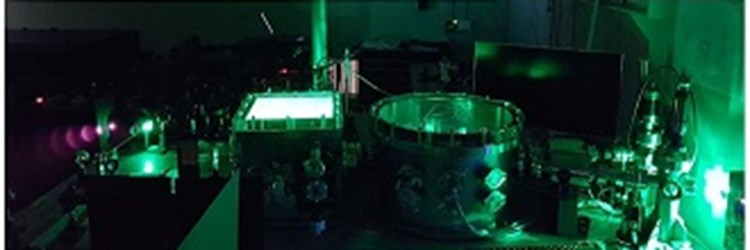

SPRINT is an High Harmonics Generation laboratory for spin and time resolved photoemission spectroscopy
The SPRINT lab is based on a double-branch high harmonic generation (HHG) beamline producing 150 fs pulsed in the range 16 –70 eV with up to 400 khz repetition rate, 1012photons/sec and energy resolution down to 20 meV.
The SPRINT lab is based on a double-branch high harmonic generation (HHG) beamline producing 150 fs pulsed in the range 16 – 70 eV with up to 400 kHz repetition rate, with 1012photons/sec and energy resolution down to 20 meV. The HHG generation is obtained by means of a Yb:KGW laser source (PHAROS), able to produce pulses at 1030 nm, with time duration of 300 fs, variable repetition rate from 50 kHz up to 1 MHz, pulse energy of 400 μJ and average power up to 20 Watts. The laser can seed two optical parametric amplifiers (OPAs), configured for operation with 40 μJ/pulse or 360 μJ/pulse. They allow for a tunable output in the range 630-2600 nm (ORPHEUS HP) and in the range 1350-4500 nm (ORPHEUS ONE HP), which is also equipped with a DFG crystal to extend the output to 16 mm, with a conversion efficiency around 10-20 %, depending on wavelength. The production of harmonics (up to the fifth) is also possible, producing 515 nm (2nd), 343 nm (3rd), 257 nm (4th) and 206 nm (5th).
The end station is equipped with standard surface preparation tools and with a Scienta SES-2002 electron spectrometer for ARPES experiments. A vectorial Mott detector(s) setup (total yield mode) is able to measure the spin polarization of the secondary electrons. Cryogenic temperature control and extremely low stray magnetic field sample environment are implemented. The samples are prepared in the annex sample preparation module that will also receive samples grown and characterized at NFFA-Trieste APE stations via a UHV shuttle.
The SPRINT lab hosts a second setup, the "Transient Grating": this is a type of Four Wave mixing technique, on which two high power laser pulses, interfere inside the sample producing a periodic spatial modulation of the index of refraction. This modulation can be probed with a third pulse, continuous or pulsed, which is diffracted by the pump induced grating. The measurements of the scattered beam intensity gives information on the relaxation of the grating, and so on the relaxation of the excited mode. Depending on the type of probe, a dynamical range from 300 fs to hundreds of µs can be covered, allowing measurements on acoustic, magnetic, structural and thermal degrees of freedom. For further information: https://www.trieste.nffa.eu/techniques/spectroscopy/tg-sprint/
Instrumentation: The high harmonic generation system was designed and realized in collaboration with Sincrotrone Trieste and with IFN-CNR (Padova, L. Poletto); a new method to increase gas pressure for generation in vacuum, and the monochromator concept contribute to reach optimal energy resolution at high repetition rate. The optical system and the delay line for laser pulses were implemented in the acquisition system for pump/probe spectroscopy. A vacuum suitcase has been developed and realized, allowing the transportation in ultra-high vacuum (10‐11 mbar, 20 hours) to and from growth and spectroscopy facilities. The Mott detector has been equipped with a new home-made acquisition and control system, specifically designed (collaboration with Sincrotrone Trieste) for twin operation (static and pump-probe). The whole measurement apparatus “Ultraspin” has been designed, developed in house, and commissioned also with contribution of a Marie Curie fellowship.
Software: The acquisition program for remote control and motorization of the HHG beamline has been developed in house. A specific software for Mott detector has been developed for high repetition measurements, and also an implementation of Scienta software for time resolved experiment has been provided (both in collaboration with Sincrotrone Trieste).
The research activity of the group is focused on electronic and magnetic properties of less than 3D systems (surfaces and interfaces), quantum materials and highly correlated systems. The strategic role of SPRINT is to enable the photoemission spectroscopy community to exploit ultrashort pulses in the linear response regime, and explore the non-linear regime by integrating photon-in photon-out methods, favoring advanced use of FEL sources. Building up on a solid knowledge of electron spectroscopies developed at APE beamline and at synchrotron sources (see projects and funding), the design, construction and operation of the NFFA-SPRINT facility represent a development of the NFFA project (WWW.Trieste.NFFA.eu) performed in collaboration with T-Rex (Elettra-ST). NFFA aims at continuously developing and operating an integrated users access infrastructure to nano-‐foundry services (growth, characterization, theory, fine analysis, FAIR data management) along with APE‐LE, APE‐HE and with partial involvement of other IOM activities (EM, MBE‐nanowires), using dedicated resources from national and European grants, under the responsibility and coordination of Giorgio Rossi (Dip. di Fisica UNIMI and IOM). Commissioning of the SPRINT‐lab (2017‐2018) achieved performances well above specifications, with first user experiment in 2019. Future experiments will address the spin dynamics in semiconductors and the hidden metallic phase in manganites, following results obtained on half metallic LSMO.
MIUR-FOE, NFFA -Trieste, 2016-2020
Horizon2020, NFFA Europe Pilot (NEP), 2021-2025
Horizon 2020 FET Open, SINFONIA, 2021-2024